Login Form
Newsletter
Support YEE
Deprecated: Methods with the same name as their class will not be constructors in a future version of PHP; plgContentJw_allvideos has a deprecated constructor in /home/html/yeenet.eu/public_html/www/archives/plugins/content/jw_allvideos/jw_allvideos.php on line 18
Deprecated: implode(): Passing glue string after array is deprecated. Swap the parameters in /home/html/yeenet.eu/public_html/www/archives/plugins/content/jw_allvideos/jw_allvideos.php on line 72
Deprecated: implode(): Passing glue string after array is deprecated. Swap the parameters in /home/html/yeenet.eu/public_html/www/archives/plugins/content/jw_allvideos/jw_allvideos.php on line 72
Deprecated: implode(): Passing glue string after array is deprecated. Swap the parameters in /home/html/yeenet.eu/public_html/www/archives/plugins/content/jw_allvideos/jw_allvideos.php on line 72
Deprecated: implode(): Passing glue string after array is deprecated. Swap the parameters in /home/html/yeenet.eu/public_html/www/archives/plugins/content/jw_allvideos/jw_allvideos.php on line 72
Deprecated: implode(): Passing glue string after array is deprecated. Swap the parameters in /home/html/yeenet.eu/public_html/www/archives/plugins/content/jw_allvideos/jw_allvideos.php on line 72
News
Nesting places for birds
Dates: Regularly on weekends since November 2016
Place: Jaunpiebalga region, Latvia
What was done:
1. Selection of forest areas for field visits; 2. Field visits with task to find nesting places of specially protected bird species; 3. Submission of data to bird experts.
What is the result of activity: We have found 15 middle and large-scale nests. At least 1 of them has been identified as nest of specially protected bird species for whom micro-reserve could be established.
Why this method: Searching of nesting places allows to identify forest areas in Jaunpiebalga region that are important for specially protected bird species and to consider possible protection measures.
What follow-up is planned: We have discussed our findings with bird experts about possible protection measures. One of possible solutions that is on process is creation of micro-reserve for protection of identified nesting area.
Additional information: http://baltadaba.lv/aktuali/environmental-challenge-accepted/
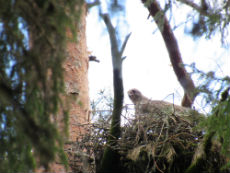 |
 |
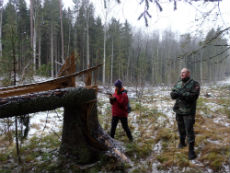 |
Reconstruction of bird houses
Dates: 1 April 2017
Place: Jaunpiebalga, Latvia
What was done:
- Communication with bird experts;
- Identification of bird houses that should be reconstructed (near local school);
- Organisation of public event;
- Field visit guided by expert in order to inform local participants about nesting habits of different bird species;
- Maintenance and reconstruction of old bird houses to provide safe nesting places;
- Creation of new bird houses.
What is the result of activity: During the activity 30 bird houses were restored and created. Participants were informed about the necessity to regularly maintain and control established bird houses. In total 14 local participants took part in the activity.
Why this method: It is very important not just to create new bird houses year by year but even more valuable is to control and maintain the existing ones in order to provide safe nesting obstacles for birds.
What follow-up is planned: In autumn we will monitor our bird houses again to evaluate weather our created houses were used by birds and to encourage local people to take initiative for next activities.
Additional information: http://baltadaba.lv/aktuali/environmental-challenge-accepted/
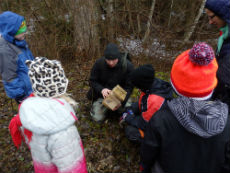 |
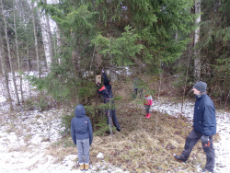 |
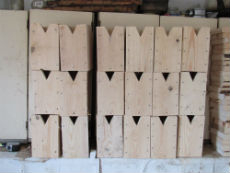 |
Creation of bird houses
Dates: Regularly since November 2016
Place: Jaunpiebalga and Gulbene region, Latvia
What was done:
- Identification of places for bird houses;
- Workshops for construction of bird houses;
- Monitoring results of nesting;
- Maintenance and cleaning bird houses for next nesting season.
What is the result of activity: During the project we renovated 53 bird houses and constructed 204 new bird houses (for different bird species: European Pied Flycatcher/Ficedula hypoleuca, Great Tit/Parus major, Tawny Owl/Strix aluco, Ural Owl/Strix uralensis, Eurasian Pygmy-owl/Glaucidium Passerinum and others). All activities were organised with involvement of children and young people who took part in creation of those bird houses in order to get knowledge about birds protection.
Why this method: There is lack of old trees where birds can nest. Holes in trees for certain bird species are places for reproducing. Creation of artificial nesting places provide ability for birds to reproduce in places where natural conditions are not good enough. Other problem is maintenance of birdhouses. Many birdhouses are built but are not safe anymore. We need to check them and renew if necessary in order to make those birdhouses effective for longer period.
What follow-up is planned: It is very important to not just create new bird houses year by year but even more valuable is to control and maintain the existing ones in order to provide safe nesting obstacles for birds. That is why it is our obligation to take care about bird houses we created and birds that are using them. We have long term plans for monitoring nesting success in our project sites and continue our activities in future.
Additional information: http://baltadaba.lv/pucu-buri-jaunpiebalgas-novada/
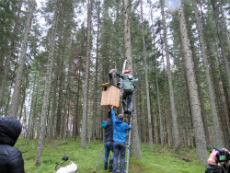 |
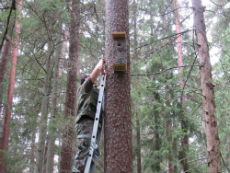 |
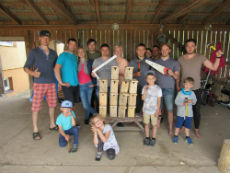 |
Funder:

Water monitoring of the Viesvile river
Dates: October 2016-summer 2017
Place: Lithuania, Viesvile
What was done:
- Project group was created (includes members of Student scientific society of natural sciences, students of Viesvile school and Young friends of forest society).
- Problems of the Viesvile river basin were stated.
- Monitoring of basic indicators in the Viešvilė river was done twice (2016 12 03; 2017 03 02).
- Water biomonitoring practical lecture was held for members of Student scientific society of natural sciences.
- Knowledge of water biomonitoring were transferred from students to local participants of group.
- First water biomonitoring in five sites of the river was done in May together with Viesvile’s Young friends of forest society.
- Preliminary results of the research were presented for town representatives.
- Further proposals for invasive plants species (Solidago virgaurea) research were given for member of Young friends of forest society.
What is the result of activity: The methodology of water biomonitoring was learned and first part of water biomonitoring was held. Members of Young friends of forest society got to know basics of the fauna, living in Viesvile river. Preliminary results of the monitoring show, that the water quality is getting worse after the river flows through the town. Further steps of invasive plants research were planned.
Why this method: Water biomonitoring shows longer-lasting water quality in the river, when compared to chemical water analysis. Also it is a great way to involve local community in the research, show the beauty of fauna living in the water and explain its importance. Invasive plants spread is an interesting and actual problem for members of Young friends of forest society. They have already started a research, searching for ways to cope with the spread of these plants, but bigger scientific background and support is needed to get more accurate results.
What follow-up is planned:
- Second water biomonitoring
- First microplastic monitoring in the Viesvile river
- Presentation of monitoring for local community during local fest
- Further support for investigation of invasive plant species
Additional information: Video made after first activity, for international biodiversity day:
More about alien species in Lithuania: http://www.glis.lt/?pid=126
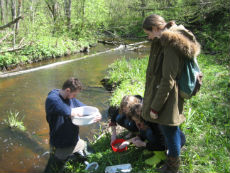 |
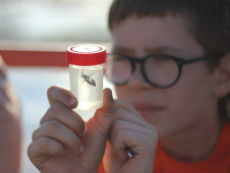 |
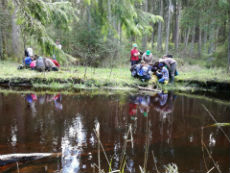 |
Water monitoring of the Viesvile river
Dates: October 2016-summer 2017
Place: Lithuania, Viesvile
What was done:
• Methodology for micro plastic investigation adapted and micro plastic research was done for first time in Viesvile river.
• Second water bio monitoring was done and water quality estimated.
• Viesvile river fauna, water quality and micro plastic issue were presented for local community during town Midsummer celebration.
What is the result of activity:
• Micro plastic particles were found in Viesvile river.
• Two water bio monitoring results support each other.
• Understanding about micro plastic issue, Viesvile river fauna and water quality was increased among town habitants.
Why did you choose this method?
Micro plastic problem is still poor known and not well researched, but it is getting more and more interest among naturalists. New investigations help to get better understanding about this issue. Society is not well informed about micro plastic issue, Viesvile river fauna and water quality. Better understanding about these issues increases people ecological awareness and contributes to their action for environmental protection.
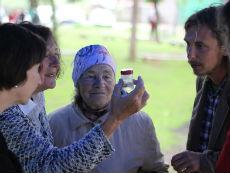 |
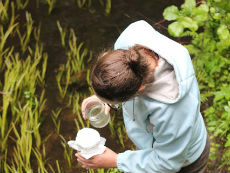 |
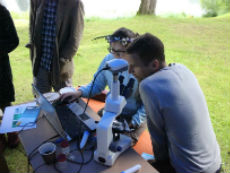 |
Invasive plant species control in Viesvile nature reserve and water biomonitoring in Viesvile river
Dates: 25/08/2017 – 27/08/2017
Place: Viesvile, Lithuania
What was done:
- Two invasive plants species - thicket shadbush ((Amelanchier spicata) and northern red oak (Quercus rubra) were chosen to control in cooperation with Viesvile Nature reserve.
- Most vulnerable places for invasive plants species spread were selected and work was done in these areas.
- Try-yourself waterbiomonitoring in Viesvile river was done together with Young Friends of the forest.
What is the result of activity?
Thicket shadbush and northern red oak were cutted in 3 areas in Viesvile nature reserve. The population of these trees was considerably reduced and the spread to the nature reserve controlled.
Why did you choose this method?
Invasive plants cause ecological problems as changing environmental conditions and outcompeting native species. Usually they grow in damaged habitats (e.g. close to roads), but in Viesvile two invasive plants – thicket shadbush and northern red oak are also spreading to nature reserve and threatening it’s specific flora. Work was done by hand tools in places, which are difficult to access and/or where these plants are distributed in large area, so it is not efficient to work with machinery.
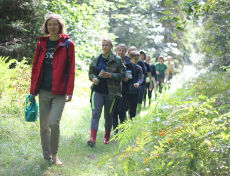 |
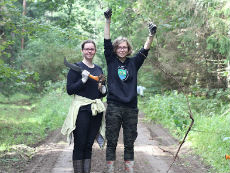 |
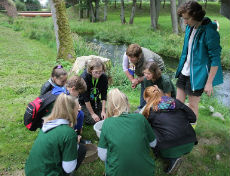 |
Funder:

Lithuanian Fund for Nature - Environmental challenges
Meeting with volunteers
Dates: 3-4 March 2017
Place: Palupõhja, Estonia
What was done: Group meeting to plan activities in summer.
What is the result of activity: With this two day meeting we focused on developing the plan on how to solve the problems in our project site - last Freshwater pearl mussel habitat in Estonia. We also discussed the publicity of the project - how to increase the interest among people, agencies and policy makers. During the meeting there were also three presentations - Kristjan Oopkaup from the University of Tartu talked about micropollutants in the water and how they affect river habitat. Dr. Kristjan Piirimäe from ELF gave an overview about agricultural diffuse pollution how it can be reduced. And finally Girts Baranovskis from Balta Daba talked about Latvian activities.
Why this method: Our plan was to have an intensive two-day meeting to get to know each other and to plan forthcoming activities. To get more input, two experts were included to give presentations about different perspectives how to deal with water pollution.
What follow-up is planned: Regular Skype meetings before intensive fieldworks in July.
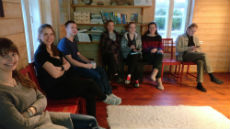 |
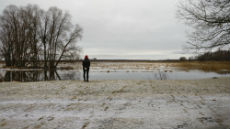 |
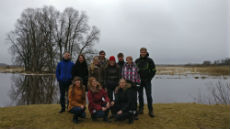 |
Restoring freshwater pearl mussel habitat
Dates: 6 - 9 July 2017
Place: Lahemaa national park, Estonia
What was done:
- Mapping problematic areas in the river (beaver dams, flow barriers, salmon spawning grounds).
- Measuring water physical-chemical parameters before and after beaver damn.
- Removing two beaver dams.
- Measuring physical- and chemical parameters of the water after beaver dam removal.
- Removing several flow barriers in the river.
- Building sediment traps into ditch entering to the river.
What is the result of activity: We found more than 40 flow barriers in the river. We found kilometres of salmon spawning grounds. We saw more than 50 freshwater pearl mussels. We removed two beaver dams and several flow barriers. Sediment trap was built into the drainage ditch.
Why this method: Freshwater pearl mussels (especially juvenile) are extremely vulnerable to the changes of river morphology and physical-chemical parameters. Sediments, which will eventually pile up in the river due to the nearby agricultural activities and forest drainage, will affect their habitat. In addition, the salmons are extremely important for mussels' life cycle and therefore it is also important to remove all the flow barriers and beaver dams for salmon to have good access to their breeding areas. Beaver damns also reduce the flow rate and increase the water table in the river, which result in lower oxygen concentration and higher water temperature. Low oxygen and high water temperature is not suitable for both salmons and mussels. Therefore it is crucial to remove all flow barriers and especially beaver dams.
What follow-up is planned: Collected data will be presented to the Estonian Environmental Board. Consultation with some experts is planned to plan further activities.
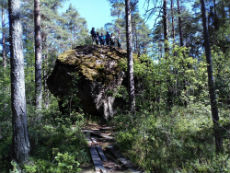 |
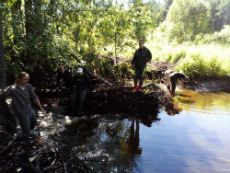 |
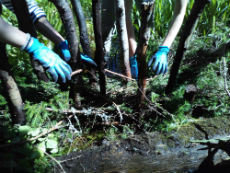 |
Restoring drained bog
Dates: 3 - 6 August 2017
Place: Soosaare bog, Põltsamaa parish, Estonia
What was done:
- Locating drainage ditches in the bog
- Building dams with peat to stop water flow from bog to ditches
What is the result of this activity: During the Soviet period, in Estonia a lot of bogs were drained to increase agricultural land and to mine peat. These highly vulnerable heterogeneous ecosystems were totally changed into homogeneous landscapes, which started to emit huge amount of carbon into the atmosphere due to the peat mineralization. In recent years, many previously drained bogs, which have not been used for forestry, agriculture etc. were restored. If drained peat lands are restored they start to sequester carbon and will help to fight against climate warming.
Why this method: Closing drainage ditches in the bog using peat, which was cut from the same bog is one of the most sustainable and effectives ways to stop water flowing away from the bog. This method will increase water level in the bog and therefore we helping Sphagnum mosses to grow and increase soil organic content.
What follow-up is planned: Evaluation of the effectiveness of the damns. If some dams are damaged they will be rebuilt.
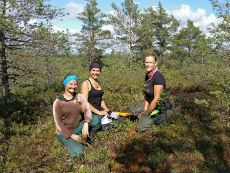 |
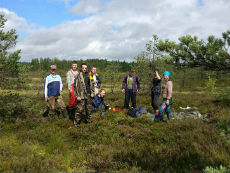 |
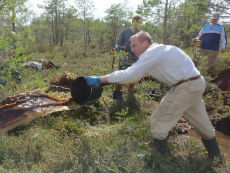 |
Funder:

Estonian Fund for Nature - Environmental challenges
Main page of the projectRestoring drained bog
Project team of the Lithuanian Fund for Nature
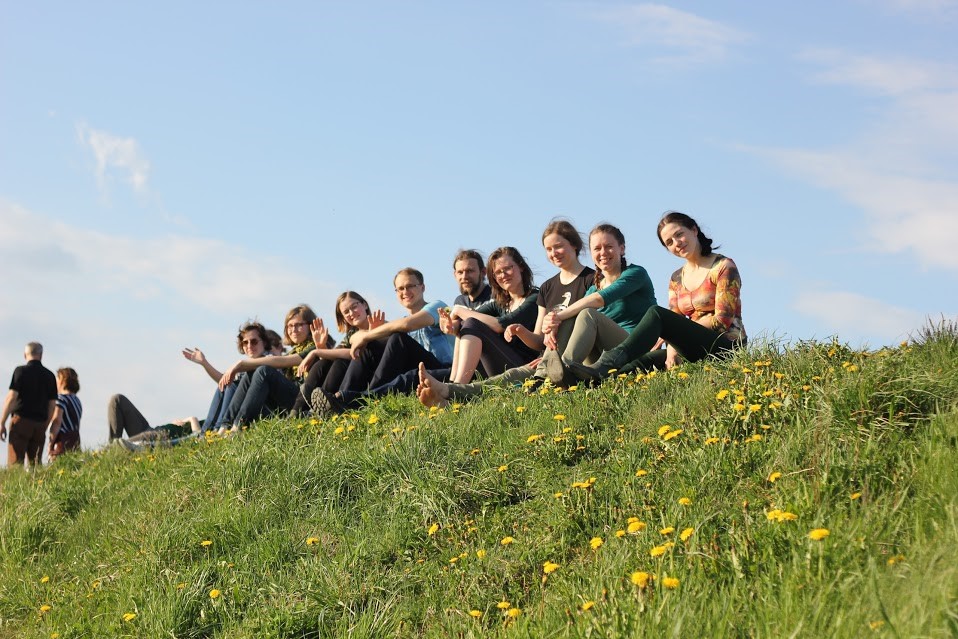
Group photo of the project group, from left to the right: Kamile Izganaityte, Milda Riepsaite, Kristina Valaviciute, Tomas Pocius, Mantas Adomaitis, Viktorija Kuodytė, Adele Markeviciute, Ruta Rutkunaite, Julija Petrosiute
|
Results of local actions What has been achieved? Was the problem solved? We reached our main goals in two fields:
Will you work on it more? How will you follow-up on the problem? We are staying in touch with Student scientific society of natural sciences and Young friends of the forest in Viesvile. Potentially we will work together on new projects in the near future. |
Water quality of Viesvile river
What is the issue: Viesvile nature reserve was founded in year 1991 to protect the basin of the Viesvile river. This river further flows through the town of Viesvile and suffers from anthropogenic influence. After the town the Viesvile river flows to the biggest Lithuanian river – Nemunas and then goes about 100 km to the Baltic sea. The biggest problem about the Viesvile river is sewage of the town (about 1000 inhabitants). The water is cleaned in local water cleaning plant, but it is suggested, that water quality is getting worse after it flows through the city. Another big issue talking about water quality is microplastic. Microplastic problem is not very well known in public yet, but it causes water pollution and especially water fauna suffers from it. The third problem is spreading of invasive species to the area close to the Viesvile river. Local students have started a research about Solidago canadensis and are looking for the ways to stop its spread, support for this research is needed.
What should be done: In order to investigate the water quality and involve local community in the process of solving water pollution problem, water bio monitoring and microplastic investigation should be done and public awareness raised. Invasive species research has to be repeated with bigger scientific background.
Expected results: The river monitoring shows the change of water quality as it flows from source to the mouth. The microplastic is investigated for the first time in the Viesvile river. Different ways of fight with invasive species are performed in Viesvile river basin area.
Funder:

PortuGreen - reforestation
Dates: 18 March 2017
Place: Mata de S. Brás, Santa Cruz do Bispo, Matosinhos, Portugal
What was done: Reforestation of Mata de S. Brás with native species and intervention against a invasive tree of the generus Acacea.
What is the result of activity: Plantation of 144 trees and bushes with the help of 60 volunteers from several organisations.
Why this method: Our plan is to restore a native ecosystem in the area of Mata de S. Brás. The help of the volunteers makes the task quicker.
What follow-up is planned: Controlling the plants to not let them dry, control of the spontaneous species so they do no cover the new plants and continuing the intervention against the invasive species so we can gain more field to plant natives.
Additional information: 100milarvores.pt; invasoras.pt
Local partners:
- União de Freguesias de Perafita-Lavra-Santa Cruz do Bispo - http://www.perafita-lavra- santacruzbispo.pt/
- Câmara Municipal Matosinhos - http://www.cm-matosinhos.pt/Estabelecimento
- Estabelecimento Prisional de Santa Cruz do Bispo - masculine
- Projecto Futuro - http://www.100milarvores.pt/
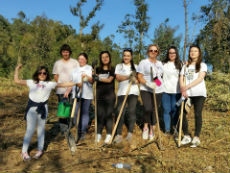 |
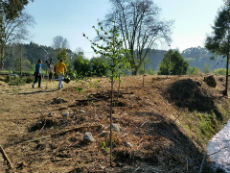 |
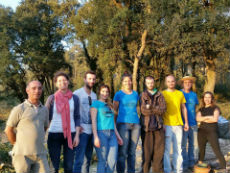 |
Phytoremediation water treatment system
Dates: 29 April 2017
Place: Guifões, Matosinhos, Portugal
What was done: Beginning of the construction of ponds that have the purpose to treat the water of a little stream. First pond - covered with a canvas, filled with gravel and planted with local plants. Second pond - covered with canvas and filled with gravel. Thrid pond - only with gravel.
What is the result of activity: All of the 3 steps completed and the ponds started to fill with water.
Why this method: To try to do this experimental method to treat this stream full of organic matter that comes from the residual water of the houses close by. By implementing this system, that have low cost, we can raise awareness for alternatives to the conventional water treatment systems.
What follow-up is planned: Monitoring the structure built. To see if it hangs on with the rain. To control the growth of the plants.
Local partners:
- União de Freguesias Custóias-Leça do Balio-Guifões - http://www.jf-custoias- lecabalio-guifoes.pt/
- Câmara Municipal Matosinhos - http://www.cm-matosinhos.pt/
- Administração dos portos do Douro, Leixões e Viana do Castelo - http://www.apdl.pt/header
- Centro Interdisciplinar de Investigação Marinha e Ambiental - http://www.ciimar.up.pt/
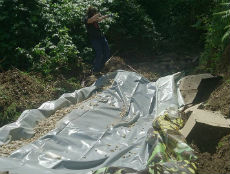 |
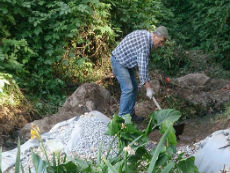 |
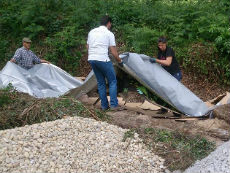 |
PortuGreen - control of invasive species
Dates: 6 May 2017
Place: Mata de S. Brás, Santa Cruz do Bispo, Matosinhos, Portugal
What was done: Peeling of trees of the generus Acacea, pulling out other invasive species and pulling out spontaneous weeds near the planted trees.
What is the result of activity: Peeling of a big number of trees. With pulling out invasive species we try to gain more space for reforestation and by pulling out spontaneous to prevent the planted trees from being suffocated by them.
Why this method: Best way documented to prevent these particular invasive species of growing.
What follow-up is planned: Keep these action till the end of the project and monitoring the growth of the plants.
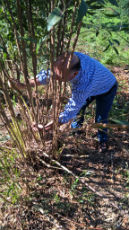 |
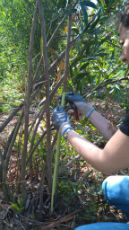 |
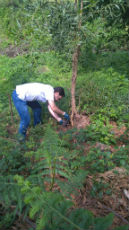 |
PortuGreen - reforestation
Dates: 17 June 2017
Place: Mata de S. Brás, Santa Cruz do Bispo, Matosinhos, Portugal
What was done: Cleaning of the spontaneous weeds surrounding the planted trees boiler and peeling of some trees of the Acacea generus.
What is the result of activity: With the cleaning of the planted trees boiler it is possible to reach them so we can keep up with the monitoring plan. The peeling of the Acacea keeps rolling the invasive species combat plan.
Why this method: If the surrounds of the trees were not cleaned, they could be suffocated by the others. Besides, it facilitates the monitoring plan as the trees become visible.
What follow-up is planned: Monitoring all the tree and check their "health" condition.
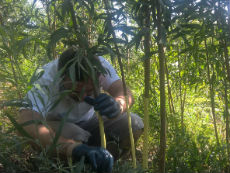 |
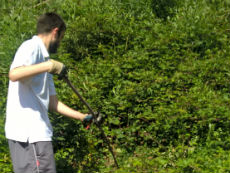 |
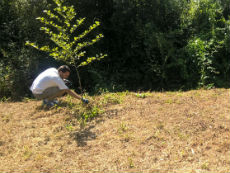 |
PortuGreen - reforestation
Dates: 12 July 2017
Place: Mata de S. Brás, Santa Cruz do Bispo, Matosinhos, Portugal
What was done: A short introduction to the international project (what it is about) and to the autochthonous Portuguese forest to children between 8 and 12 years old. After that we made a practical activity of removal of the weeds from the surrounding areas of the planted trees and the peeling of the generus Acacia, and invasive tree that exist in the field.
What is the result of activity: To get to the planted trees is now easier and we got more invasive ones peeled, which helps the working group of the project to accomplish this important task of their work.
Why this method: It is the one we have been to applying since the beginning of the project.
What follow-up is planned: The maintenance of the planted trees (watering).
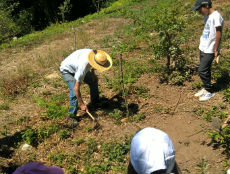 |
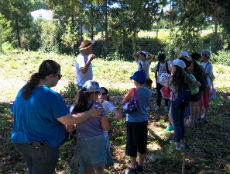 |
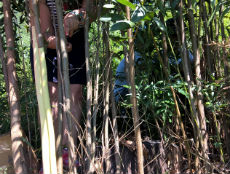 |
PortuGreen - maintenance
Dates: 21 October 2017
Place: Mata de S. Brás, Santa Cruz do Bispo, Matosinhos, Portugal
What was done: Cleaning the surroundings of the planted trees and protecting them with a plastic tube.
What is the result of activity: The cleaning of the surroundings of the planted trees prevents the trees from suffocation by the spontaneous weeds. The protection tubes prevents the trees trunks to get hurt by the cleaning process or any wild animal.
Why this method: It is the most common used in the reforestation processes and it is easy to do.
What follow-up is planned: To meet with all the local partners and schedule future actions such as cleaning of the invasive species, monitoring the planted trees and planning next plantation actions.
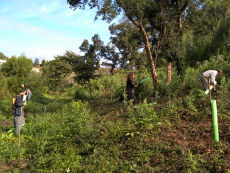 |
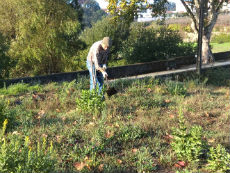 |
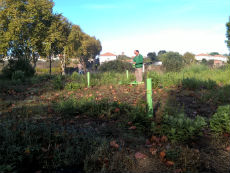 |
Funder:

OPE - Environmental challenges
Main page of the projectPortuGreen - maintenance










